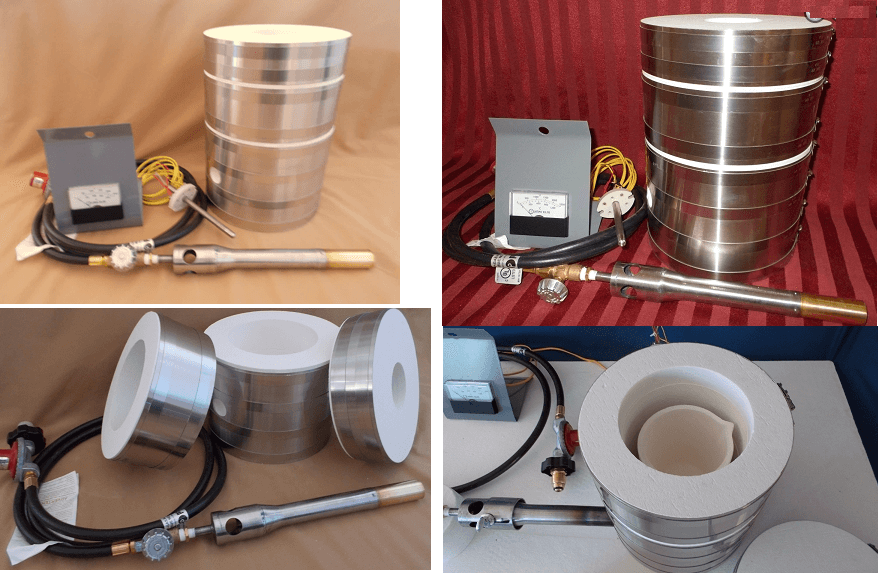
Propane Melting FurnaceThe burner supplied with the KK-8 is unique in its design and is comprised of a bi-metal construction. The burner is constructed of mild steel with a brass nozzle tip in order to eliminate the corrosive environment created by the use of a conventional steel or stainless steel burner nozzle with the kiln. When a conventional steel burner nozzle is heated by the burning propane gas and atmospheric oxygen exiting the nozzle, a portion of the nozzle will flake or ‘scale off’, into the interior of the kiln. This scale is extremely corrosive and will rapidly attack the pyrometer probe, the refractory insulation and the crucible. This ultimately results in an unsatisfactory iron-rich scale contaminated environment within the kiln, which is not desirable when melting pure metals and performing fire assays.
BUY a Metal Melting Furnace
The bi-metal burner design eliminates the ‘scaling’ problem in the following manner: The brass portion of the burner is not susceptible to any ‘scaling’ when heated by the propane flame exiting the burner tip and, by the time the heat of the burner tip is transmitted to the steel portion of the burner, the temperature is far below the temperature that the mild steel would ‘scale off’ at. The design and application of the bi-metal burner used with the KK-8 eliminates this scaling and corrosive environment entirely, which contributes to a pristine, reduced environment within the kiln, ideal for melting metals and assaying.
The burner supplied with the KK-8 produces approximately 160,000 BTU at 30 psi, however the KK-8 only requires approximately 30-35% of the burner’s rated output to achieve 2200° F. As a result of the burner’s extra capabilities, the burner performs in a highly efficient manner, while operating at the reduced BTU requirements of the kiln. It is therefore necessary that a pyrometer be used in conjunction with the kiln, as it is very easy to ‘over-fire’ the kiln with the burner and damage the insulation from excessive temperatures. The burner is so efficient, that, when the kiln has warmed up and with the burner in the ‘idle mode’, the temperature of the kiln remains at approximately 1700° to 1800° F.
The burner is a venturi design. The propane under pressure rapidly travels down the burner tube, which in turns draws atmospheric oxygen into the burner tube through the large holes in the base of the burner. When this mixture of propane and atmospheric oxygen reaches the interior of the kiln, the velocity of the gases is reduced and the combustion takes place inside of the kiln. This design is efficient and effective, however it is susceptible to wind and it is recommended that, if used outside, suitable wind breaks be placed around the base of the burner, to defect the wind away from the holes in the base of the burner, if necessary.
The KK-8 is constructed of a Stainless Steel-Tension Adjustable Jacket, surrounding Alumina Silicate Refractory Insulation that comprises the interior of the kiln. The refractory insulation has an operating temperature rating of 2300° F. The liner of the kiln is constructed in a layered and stacked configuration and is less susceptible to cracking from thermal expansion and contraction, as each layer can expand or contract separately. Another feature of the layered and modular design is that individual sections of the kiln liner can be replaced at a fraction of the cost of replacing the whole liner, in the event of a serious spill or boil over of the crucible.
___
During the initial firing of the kiln, the refractory insulation will shrink approximately 5%, due to a portion of the silica micro-fibers that comprise the insulation being fused together by the heat. A break-in procedure will be outlined later in the instructions during the initial firing of the KK-8.
The Alumina Silicate Refractory insulation is not degraded by the flame alone. However; the insulation is susceptible to erosion by spilled borax. Borax is a common component of most all of the fluxes used in melting and assaying, so care must be taken not to spill borax flux onto the insulation. Methods for repairing and stopping any spilled borax from fluxing the insulation will be outlined in these instructions.
Contact me for a Propane Melting Furnace.
